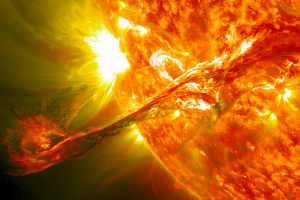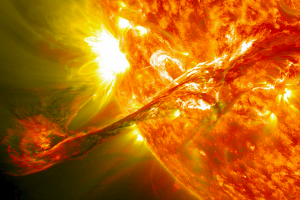 [1]When you’re preparing for a disaster, you have to weigh two very important factors. How destructive will it be, and what is the likelihood of it happening. If the likelihood is really low, then it may not be worth the extra time, money, and effort to prepare for it, even if it may be extremely catastrophic.
[1]When you’re preparing for a disaster, you have to weigh two very important factors. How destructive will it be, and what is the likelihood of it happening. If the likelihood is really low, then it may not be worth the extra time, money, and effort to prepare for it, even if it may be extremely catastrophic.
Of course, there are some disasters that are strong candidates for both categories. I’d say a solar storm is definitely one of them, and is equal only to a nuclear war in terms of likelihood and destructive potential. And by that I mean, it doesn’t happen every day, but if it does, look out. Such an event almost happened in 2012 [2], when a solar storm that was comparable to the famous Carrington Event [3] whipped past Earth. If the storm had erupted from the sun roughly a week earlier, you might not be reading this right now.
While science is still learning about these coronal mass ejections, we do have an idea of what they’re capable of. If one were to hit Earth, it could destroy many of the power grids on our planet and take down numerous satellites. It could totally wreck the global economy in one fell swoop. The power could be out for years in some regions, and millions may die. Meanwhile governments have largely failed to prepare for this sort of disaster, even though it would take very little money to do so [4],
If that’s not scary enough, recent documents from the UK’s Department of Business, Innovation, and Skills, have revealed some frightening facts about the speed of these solar storms. If another Carrington level event were to occur, we would have precious little time [5] to prepare, and prevent the damage to our electrical grid.
“Most coronal mass ejections are not emitted in the direction of Earth,” the report says. “Those that are typically take one to three days to reach us, and we can predict the arrival time to within about six hours. Predictions are currently less accurate due to degradation in the satellite capability available to forecasters.
“Generally speaking, the faster the ejection, the greater the potential impacts. The Carrington event, for example, travelled to Earth in as little as 18 hours. It is therefore likely that our reasonable worst case scenario would only allow us 12 hours from observation to impact.”
The Carrington event is often described as the perfect storm. The modern day effects of a similar event would include localised power outages; disruption of satellite operations, including to GPS and satellite communications; disruption to high-frequency communications; increased radiation to aircrew and passengers in flight, particularly over polar regions; and further disturbances to small-part electronic systems.
Unfortunately, that “12 hours” number doesn’t tell the whole story. It’s probably true that during a worst case scenario, it would take 12 hours for a solar storm to reach Earth. The only question is, can our scientific instruments detect a solar storm in that time frame?
Currently, our planet’s early warning system consists of a satellite called DSCOVR, which launched in February of this year, and reached its destination between the Earth and the Sun last June. The satellite it replaced could give us a 15 minute warning, but the DSCOVR satellite isn’t much of an improvement. It only gives us a 30-45 minute warning [6].
Which begs the question, what is this UK report talking about? Is it an honest mistake from an agency that lacks a scientific background? Do they have some kind of early warning system that the public isn’t aware of? Or is their report an attempt to lead the public to believe that the situation isn’t as dire as we thought?
Whatever the case may be, human civilization is still extremely vulnerable to these sorts of threats. If a solar storm were heading our way, there’s a good chance that we wouldn’t have enough time to prepare our electrical grid for the devastation it would incur.
